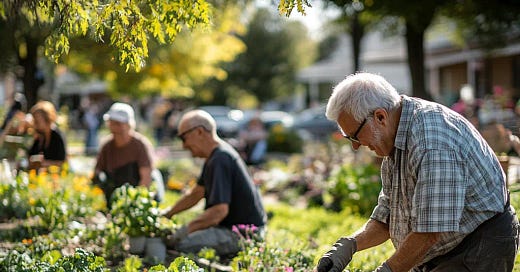Picture this: a sunny morning, the scent of fresh soil, and the joy of harvesting homegrown vegetables alongside friends. Starting a community garden at your senior center can transform this vision into reality. Beyond the delight of nurturing plants, gardening offers numerous benefits, from physical activity to fostering social connections. Let's explore how to cultivate a thriving community garden that enriches both body and soul.
Assess Interest and Form a Group
Begin by gauging interest within your community. Discuss the idea with fellow residents and staff to identify those eager to participate. Forming a dedicated group ensures shared responsibility and diverse input, making the planning process more enjoyable and effective.
Plan the Logistics
Consider the following factors to set a solid foundation for your garden:
Location: Choose a spot that receives ample sunlight, has access to water, and is easily accessible for all participants.
Size: Determine the garden's scale based on available space and the number of interested members.
Type of Garden: Decide between in-ground beds, raised beds, or container gardening, keeping in mind the mobility and comfort of participants.
Host an Initial Meeting
Organize a kickoff meeting to bring interested members together. This gathering serves as an opportunity to:
Introduce Members: Allow participants to get acquainted and share their gardening experiences or aspirations.
Discuss Goals: Establish the garden's purpose, whether it's growing vegetables, cultivating flowers, or simply enjoying the therapeutic aspects of gardening.
Assign Roles: Delegate responsibilities such as planning, planting, maintenance, and coordination to ensure smooth operation.
Design the Garden
When designing your garden, consider the selection of plants, accessibility for all members, and aesthetic elements that enhance the experience. Choosing the right plants is essential for a successful community garden. Consider a variety of options that cater to different interests and abilities:
- Vegetables and Herbs
Easy-to-grow options like lettuce, tomatoes, radishes, and basil are great for beginners.
Herbs like mint, rosemary, and chives require minimal maintenance and can be used in everyday cooking.
Root vegetables (carrots, potatoes) may require deeper soil, so consider where they will be planted.
- Flowers and Pollinator-Friendly Plants
Marigolds and lavender can repel pests naturally while adding color to the garden.
Pollinator-friendly plants like sunflowers and zinnias attract bees and butterflies, improving the ecosystem.
- Perennials vs. Annuals
Perennials (like strawberries and lavender) return year after year with minimal replanting.
Annuals (like tomatoes and cucumbers) provide a fresh harvest but require replanting each season.
Accessibility: Making Gardening Enjoyable for Everyone
A truly inclusive garden is one where all members, regardless of mobility, can participate comfortably. Consider the following when designing paths and garden beds:
- Paths and Walkways
Smooth and Wide Paths – Ensure pathways are at least 3-4 feet wide to accommodate wheelchairs and walkers.
Non-Slip Surfaces – Use gravel, pavers, or rubber mulch to prevent falls and make navigation easier.
Clear Layout – Keep pathways simple and easy to follow to avoid confusion or obstacles.
- Garden Beds: Raised vs. Traditional In-Ground
One of the biggest decisions in garden design is whether to use raised garden beds or traditional in-ground planting. Each has its advantages and drawbacks.
Raised Garden Beds:
✅ Advantages:
Easier on the joints: No need to bend or kneel, making it ideal for seniors with arthritis or mobility challenges.
Better soil quality: You can control the soil mix, which improves drainage and plant health.
Fewer weeds and pests: Raised beds reduce weed growth and protect plants from some ground-dwelling pests.
Longer growing season: Soil warms up faster in the spring, allowing for earlier planting.
❌ Disadvantages:
Higher initial cost: Materials like wood, metal, or bricks add an upfront expense.
Requires construction: Setting up raised beds takes time and effort.
More frequent watering: Raised beds dry out faster than in-ground gardens, especially in warm climates.
In-Ground Gardening:
✅ Advantages:
More affordable: No need for extra materials—just plant directly in the soil.
Less maintenance after setup: Once established, in-ground gardens retain moisture better and require less watering.
Natural plant growth: Deep-rooted plants like tomatoes and squash thrive in open soil.
❌ Disadvantages:
More physical strain: Bending, kneeling, and weeding can be challenging for seniors with mobility issues.
More weeds and pests: In-ground gardens are more susceptible to invasive weeds and critters.
Longer soil preparation: Amending the soil may take extra time before planting.
Gather Supplies and Resources
Equip your garden with the necessary tools and materials:
Tools: Secure basic gardening tools such as trowels, gloves, watering cans, and pruners.
Soil and Compost: Obtain quality soil and compost to promote healthy plant growth.
Plants and Seeds: Source seeds or seedlings from local nurseries or community programs.
Funding: Explore grants, donations, or fundraising opportunities to support the garden's establishment and maintenance.
Plant and Maintain the Garden
With planning complete, it's time to get your hands dirty:
Planting Day: Organize a communal planting event to foster enthusiasm and ownership among members.
Maintenance Schedule: Develop a routine for watering, weeding, and harvesting. Rotate tasks to ensure equitable participation and prevent burnout.
Education: Provide resources or workshops on gardening techniques, pest management, and seasonal planting to empower members with knowledge and confidence.
Foster Community Engagement
Enhance the garden's role as a community hub by:
Hosting Events: Plan regular gatherings such as potlucks featuring garden produce, workshops, or social hours in the garden space.
Sharing the Harvest: Distribute surplus produce among members or donate to local food banks to strengthen community ties.
Celebrating Milestones: Acknowledge the garden's progress and members' contributions through celebrations or recognition events.
Start Growing Together
Starting a community garden at your senior center is more than just planting seeds—it’s about cultivating friendships, sharing laughter, and watching something beautiful grow together. As you embark on this journey, remember: It doesn’t have to be perfect; it just has to bring joy.
Now, what are you waiting for? Gather your group, grab some seeds, and start planting! What’s the first thing you’d love to grow? Let us know in the comments below—we’d love to hear from you.




